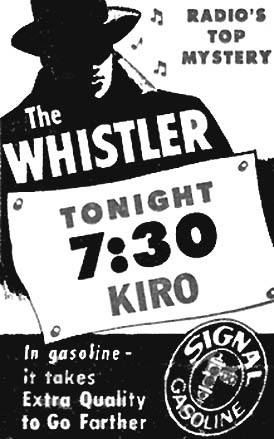
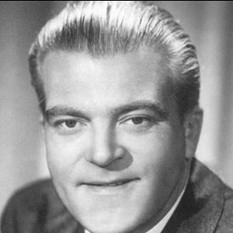 “I am the Whistler, and I know many things, for I walk by night. I know many strange tales, hidden in the hearts of men and women who have stepped into the shadows. Yes… I know the nameless terrors of which they dare not speak.”
“I am the Whistler, and I know many things, for I walk by night. I know many strange tales, hidden in the hearts of men and women who have stepped into the shadows. Yes… I know the nameless terrors of which they dare not speak.”
The Whistler (May 16, 1942-September 22, 1955) aired “The Shrunken Head” on June 13, 1942, as one of the earliest of its approximately 690 west coast episodes. There were two attempts to break into the east coast market that didn’t last long (July-September 1946, and March 1947-September 1948) due to mediocre ratings, so if these episodes are counted as part of the overall scheme of things, the total number of shows ends up somewhere around 769. Over its thirteen-year west coast run it never took a summer break and ran continuously, certainly some kind of record, and its sole west coast sponsor, Signal Gas & Oil* remained loyal throughout. While the show had several narrators over the years, the one who held the longest tenure and is most associated with the show was Bill Forman (photo top right).
*(Signal Gas & Oil has a long history. Founded in 1922, the very short version is that in 1985 Signal Companies and Allied Corp. merged to form Allied-Signal. In 1999, Allied-Signal bought Honeywell for $15 billion and subsequently has gone by the Honeywell name. But Signal Gas had its origins in the 1920s, and by the 1950s was the largest independent oil company on the entire west coast, and was thus able to easily afford to sponsor a radio show as popular as The Whistler even as early as the 1940s and in the midst of World War II.)
The Whistler has an interesting backstory, and would take much too long to go into here to give it the justice it warrants. A few points of interest will suffice for this initial offering of the beloved mystery show, the first of which is the use of the narrator as more than just a host. From Jim Ramsburg’s Gold Time Radio entry on The Whistler: “Like The Shadow’s first personification a dozen years earlier, Inner Sanctum’s ghostly Raymond in 1941 and The Mysterious Traveler in 1943, The Whistler stood outside the stories he narrated. Unlike the others, he used a unique second-person, present tense technique as if to talk directly with the central character of his stories – often an innocent drawn into the plot by circumstances or an amateur driven to murder as a last resort.” A second point of interest has to do with the trademark whistling that opens each episode. From Radio Spirits‘ Blog Archive on The Whistler: “The program featured one of radio’s classic openings: a haunting 13-note theme created by Wilbur Hatch (who also composed the show’s eerie mood music). Hatch estimated that only one person in twenty could whistle this exact melody, and for the show’s thirteen-year duration one person pretty much did—a young woman named Dorothy Roberts. In fact, during the war years, Roberts had to get permission from Lockheed (where she worked) to leave her factory job in order to make it to the program and whistle every week.”
The radio show proved popular enough that Columbia Pictures made eight Whistler films from 1944-48, all but one starring Richard Dix: The Whistler (1944), The Mark of the Whistler (1944), The Power of the Whistler (1945), The Voice of the Whistler (1945), Mysterious Intruder (1946), The Secret of the Whistler (1946), The Thirteenth Hour (1947) and The Return of the Whistler (1948). The show was brought to early television in 1954-55, but never caught on. Nevertheless (and due in great measure to roughly 500 of the estimated 700+ original shows still surviving–and the movies still showing up on classic movie tv channels), The Whistler probably enjoys a larger audience today than it did in its heyday during the Golden Age of Radio.
“The Shrunken Head” is one of the few episodes with at least a whiff of the supernatural to it, for most of the shows were mysteries. It involves a somewhat overused plotline (with slight variations)–in this case an heiress arrives at her eccentric and dying uncle’s old manse to wait for the reading of the will upon his imminent death. While there, she discovers his extensive collection of shrunken heads from early adventurous expeditions in his youth. Except, of course, one seems to come alive and…that’s as much as I can reveal without a spoiler. I will say, that like all episodes of The Whistler, there is some sort of twist or revelation at the end that you won’t see coming.
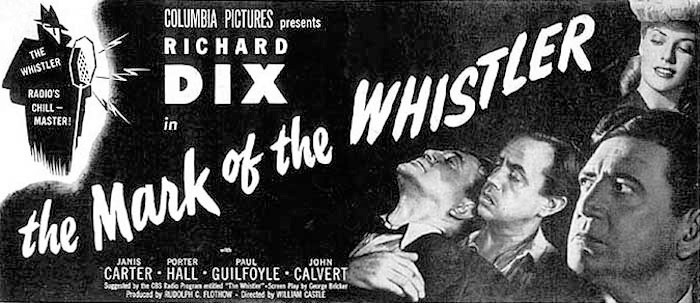
Play Time: 30:25
{With the United States having declared war on Japan a scarce 7 months earlier, the neighborhood gang left adult problems and worries to their parents and, undaunted, still made their way to the corner newsstand to enter fictional worlds and adventures through the pages of thier favorite pulp magazines. Astounding SF (1930-present, now Analog) was a favorite and held to its long-standing monthly schedule in the middle of 1942. Unknown Worlds (1939-43, affectionately known simply as Unknown), was editor John W. Campbell’s fantasy counterpart to Astounding, a venue for a certain type of story that wasn’t right for his Astounding SF audience. While much beloved of authors and readers at the time, it would fold all too quickly (after 39 issues) though it published high quality material by some of the most sought-after names in the field (as with this issue’s L. Sprague de Camp, co-author of The Mysterious Traveler old time radio show and accompanying magazine of the same name, Robert Arthur, and Anthony Boucher who, along with co-editor J. Francis McComas, would become the first editors of The Magazine of Fantasy [& Science Fiction was added to the cover of issue #2] in the fall of 1949). Unknown was a bi-monthly in 1942. Startling Stories (1939-55) always attracted the bright eyes and imaginations of its young male target audience, and this issue was no exception. Note the blurb for Noel Loomis’ story “City of Glass” as it teases with a tale of the “Silicon World.” While it can be argued that we are living in a silicon world today, I don’t think Loomis had our world in mind when he penned his fantastic tale–although we do have a “Silicon Valley.” Startling was also a bi-monthly publication in 1942.}
[Left: Astounding, June 1942 – Center: Unknown Worlds, June 1942 – Right: Startling Stories, July 1942]
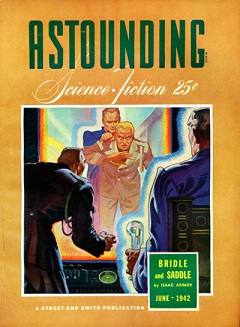
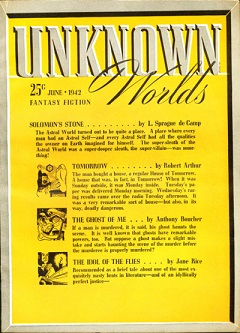
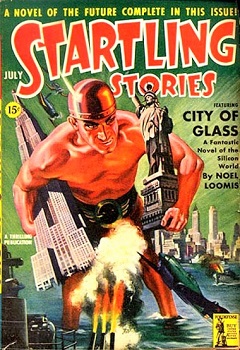
To view the entire list of weekly Old Time Radio episodes at Tangent Online, click here.